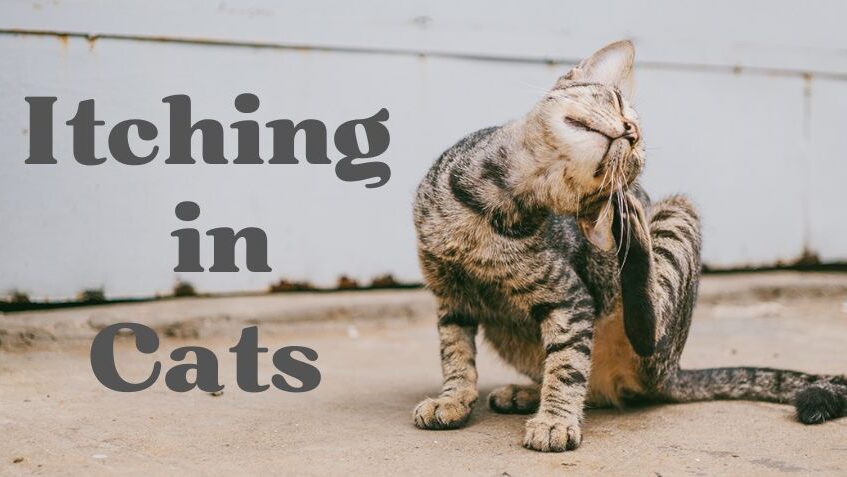Common Causes of Itching in Cats
When itchiness is severe cats may display various symptoms, the most obvious of which being excessive scratching or licking. The itchiness and related symptoms may occur seasonally or could happen year-round.
Itching is an uncomfortable and ongoing situation for your pet. They would feel much happier if the problem is resolved. Itching can also lead to lots of licking or scratching at the area, which will cause inflammation of the skin. Excessive licking can actually damage the skin, leaving open wounds prone to infection.
Additional symptoms unrelated to itchiness may also be observed depending on the underlying cause of itching in cats:
- Fleas
Just because you can’t see them doesn’t mean they’re not there! Cats can have a very dense hair coat and even if you comb through with a flea comb and don’t see any fleas or flea dirt, they may still be lurking. You can recognize flea dirt as black spots of ‘gritty’ material which can often, but not always, be seen on the skin.
Fleas are very common external parasites in cats. These pesky parasites are always the first suspects when a cat is itching like crazy. While some cats suffer only minor itching when bitten by fleas, some are allergic to an allergen in the flea saliva. These hypersensitive cats experience intense itching from even just a flea bite or two.
Fleas usually deposit flea dirt along the cat’s lower back, neck, and base of the tail. Even if there are no signs of fleas, your vet may recommend a treatment trial using a flea medication that is safe for cats. If there are several pets in the household, all must be treated even if only one cat is itching.
- Mites
Cats can be affected by a few different species of mite. Some can affect the whole body, but can also be localized, such as ear mites (Otodectes) which can cause violent scratching of the ears and are often accompanied by ear infections which might produce discharge and a smell around the ears. Harvest mites can also be a problem around late summer and autumn, these are bright orange and visible to the naked eye. They are mostly found between the toes and in the little flaps of skin along the side of the ear-tip (the Henry’s pocket).
Cats that spend time outdoors are more likely to be infested. If your vet suspects an infestation of skin mites, skin scrapings may be performed to check for the presence of the parasites. Mite treatment includes a topical medication or lime sulfur dips.
- Food Allergies (Cutaneous Adverse Food Reactions)
Allergies are more common in cats than most people think! They can be caused by a wide range of things, with fleas being by far the most common cause. Cats can have severe reactions to the flea’s saliva when they bite, and so even one flea can cause a large skin reaction. Other potential causes include outdoor allergens such as pollens and grasses. Things inside such as dust mites and dander (skin particles). If your cat seems to vary in their itching across the year; or react particularly badly to certain areas of the garden, this can be a big clue. Your vet can perform tests on your cat to look for allergy reactions.
If your vet suspects a food allergy is behind your cat’s itchy skin, a food trial may be conducted. This will involve placing your cat on a novel, hypoallergenic diet for 8-10 weeks. The diet will contain ingredients that your pet hasn’t eaten before, such as duck or venison. Even if an alleviation of symptoms is already evident in 3-4 weeks of the diet, the 6-8-week trial period must be completed. Most vets recommend a prescription hypoallergenic diet for food trials instead of over-the-counter hypoallergenic pet foods.
A food trial is usually performed after your vet has checked your cat for other diseases in which itching is a prominent sign.
- Infections
Infections of the skin by bacteria, fungi, or yeasts can cause itchiness in cats, usually alongside sore, red patches of skin. Bacterial skin infections in cats are not hugely common but can be secondary to other issues. If diagnosed by your vet, improvement will likely be seen with courses of antibiotics. Similarly, yeast infections are not often seen as a primary concern but may need medication to resolve. Fungal infections are not usually itchy.
- Insect bites
Just as in people, wasp and bee stings can cause large painful welts on cats’ skin. Smaller insects such as midges, flies, and mosquitoes can cause fairly dramatic itching. Sadly, cats can be very sensitive to the insect saliva injected as they bite. Insects often pick the non-hairy areas to bite, such as the bridge of the nose or the ear-tips. Watch out for small red lumps on non-haired areas, especially in the summertime.
- Psychological factors
This is a tricky one to pinpoint, but some cats overgroom themselves with no obvious ‘medical’ cause. Cats can groom themselves as a calming mechanism and overindulging in this can lead to sore patches of skin and bald patches – commonly on the tummy. Consider this option if you have had your cat checked by a vet and they cannot find any known medical cause; and if you have had any recent changes to your household such as a new pet or building work. It’s worth discussing with your vet if you feel any emotional factors may be playing a role in your cat’s skin problems as they may be able to suggest ways to help minimize anxiety and discuss supplements that may help.
Treatment of Itchiness in Cats
The treatment prescribed by your veterinarian will depend on the underlying cause of the itchiness. Treatments may vary considerably depending on what is causing the animal’s itchiness.
Visit your veterinarian as early recognition, diagnosis, and treatment are essential.
You may also visit – https://www.facebook.com/angkopparasahayop




